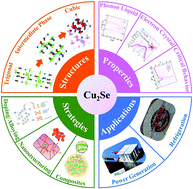Cu2Se-Based liquid-like thermoelectric materials: looking back and stepping forward
Abstract
High-performance liquid-like thermoelectrics have attracted global renewed attention since the paradigm of ‘phonon-liquid electron-crystal’ was proposed in 2012. As one of the most typical liquid-like thermoelectric materials, Cu2Se-based compounds have been widely studied and their thermoelectric figure of merits have continuously increased up to >2.0. Herein, a comprehensive overview is presented on the recent progress and future challenges for Cu2Se-based thermoelectric materials. First, the basic properties of Cu2Se, such as the complex crystal structures, unique liquid-like behavior, and anomalous critical phenomenon during phase transition are presented. Next, some common synthesis recipes are concisely outlined and the impact on the thermoelectric properties is intercompared. The effective strategies for improving the thermoelectric performance are then summarized, with some typical studies highlighted. Furthermore, the utmost concerned stability issues, in particular Cu ion migration, are discussed followed by the latest progress on Cu2Se-based thermoelectric devices. Finally, the challenges and outlook toward further development of Cu2Se-based materials, devices, and applications are provided.



 Please wait while we load your content...
Please wait while we load your content...